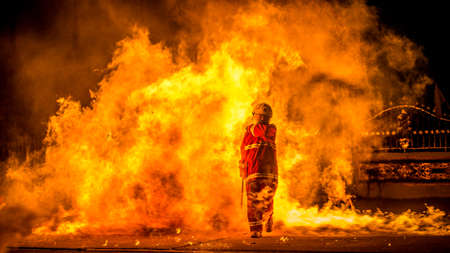Choosing the Perfect Campsite and Fire Layout
When it comes to mastering the art of campfire building while backpacking, success begins long before you strike a match. Your first mission: select a campsite and fire location that ticks all the right boxes for legality, safety, and environmental respect. Always check local fire regulations—many national forests and parks have restrictions or seasonal bans, so do your homework before heading out.
Legal and Low-Impact Site Selection
Scout for an established campsite whenever possible; these are often marked with durable surfaces like gravel or bare earth. This practice prevents scarring pristine areas and keeps your impact minimal, following the Leave No Trace ethos. Set up at least 200 feet from lakes, rivers, and streams to protect fragile riparian zones and avoid contaminating water sources.
Assessing Hazards and Fire Safety
Before committing, survey overhead for dead branches (“widowmakers”) and steer clear of dense brush or dry grass—these are tinderboxes waiting for a spark. Choose flat ground away from prevailing winds, which can whip embers into nearby tents or forest duff. If there’s already a fire ring, use it; otherwise, only build a new one if fires are permitted and absolutely necessary.
Efficient Fire Layout for Cooking and Warmth
Design your fire site with purpose: keep the area compact yet functional. Scrape away any flammable debris down to mineral soil or use a pre-existing fire ring. Arrange rocks in a circle to contain your blaze and create a windbreak. For cooking efficiency, orient your fire pit so that prevailing winds feed oxygen but don’t scatter sparks toward your gear. Always keep your setup simple—this isn’t the place for backcountry pyrotechnics.
Following these guidelines means you’ll not only stay on the right side of wilderness law but also ensure your campfire leaves no lasting trace—a true badge of backcountry mastery.
2. Gathering and Prepping Fuel: Tinder, Kindling, and Firewood
When it comes to building a reliable campfire in the American backcountry, your fire is only as good as the fuel you feed it. Responsible sourcing and proper preparation of tinder, kindling, and firewood are non-negotiables for both Leave No Trace ethics and effective firecraft. Always check local regulations first—some areas prohibit gathering wood or have strict rules due to wildfire risk.
Sourcing Fuel Responsibly
Never cut live trees or strip branches from standing timber. Instead, collect only dead and downed wood that snaps cleanly when broken. This not only protects the ecosystem but also ensures your fuel burns efficiently with less smoke. Stick to small diameter wood—nothing thicker than your wrist—to guarantee thorough combustion and easier extinguishing.
Understanding Local Wood Types
| Region | Common Wood Types | Burn Quality |
|---|---|---|
| Pacific Northwest | Douglas fir, Western hemlock, Red alder | Fir is excellent for long burns; alder ignites quickly but burns fast |
| Rocky Mountains | Lodgepole pine, Aspen, Spruce | Pine ignites easily; aspen burns hot but may produce more ash |
| Southeast US | Oak, Hickory, Pine | Oak and hickory burn slow and hot; pine is great for kindling but resinous smoke can be pungent |
Tinder, Kindling, and Firewood Sizing Guide
| Material Type | Description | Typical Size |
|---|---|---|
| Tinder | Finely shredded dry material (e.g., dried grass, pine needles, birch bark) | Pencil lead thickness or smaller |
| Kindling | Small twigs or splinters—dry and easy to snap by hand | Pencil to thumb thickness (up to 0.75”/2cm) |
| Firewood/Fuelwood | Larger sticks or split logs—well-seasoned, deadfall only | No thicker than your wrist (about 2–3”/5–7cm) |
Assessing Dryness in the Field
- Bend Test: Snap a branch—if it breaks cleanly with a sharp sound, its dry enough.
- Bark Check: Loose or peeling bark often means good dry wood underneath.
- Weight: Dry wood feels lighter than fresh green wood of similar size.
- Avoid: Soft, punky (spongy), or moss-covered wood—it smolders instead of burning hot.
Pro Tip: Prepping Like a Pro
Bust out your knife or hatchet to create feather sticks from larger kindling if conditions are damp. Shave off thin curls to expose dry inner wood—even after rain. Stack your materials in separate piles (tinder, kindling, firewood) before lighting up so you’re ready to build heat fast once the match strikes. Remember: gather double what you think youll need—you’ll always burn through more fuel than expected when night falls and the stories start flowing around the flames.
![]()
3. Igniting the Blaze: Time-Tested Fire Starting Techniques
When it comes to building a reliable campfire in the American backcountry, your ignition method is just as important as your woodpile. The seasoned backpacker knows that conditions can shift fast—one minute it’s a dry summer evening, the next you’re battling drizzle and gusts. That’s why every fire master carries a trio of tried-and-true ignition tools: the trusty Bic lighter, waterproof matches, and the rugged ferrocerium (ferro) rod.
Bic Lighters: The Everyday Hero
No nonsense, cheap, and easy to use, a Bic lighter is an American classic for good reason. Toss one—or two—into your kit. They’ll spark dozens of fires with minimal fuss, but remember: cold temps or dampness can make lighters unreliable. Always keep them dry and warm in an inside pocket.
Waterproof Matches: Old-School Reliability
Stormproof or waterproof matches offer backup when wind and rain threaten your main source. Strike-anywhere tips let you light up on rocks or even zippers if needed. Store matches in a sealed plastic container; moisture ruins their magic in seconds.
Ferro Rods: For When It Really Matters
If things go sideways—a soaked pack, dropped gear, or frozen hands—a ferro rod will still throw hot sparks onto tinder no matter what. Practice at home before you head out; ferro rods demand solid technique. Scrape hard with the spine of your knife to shower sparks onto dry cotton balls smeared with petroleum jelly or other reliable tinder.
American Field Wisdom
Mix and match your methods, and always bring redundancy. Veteran backpackers know that lighting a fire isn’t about luck—it’s about preparation and skill. Whether you’re cowboy camping under Montana stars or hunkered down in Oregon drizzle, mastering these American favorite fire-starting techniques ensures you’ll never be left cold in the wild.
4. Keeping It Lit: Campfire Maintenance and Heat Control
Once your campfire is crackling, the real work begins. Mastering fire maintenance isn’t just about tossing on more logs—it’s about efficiency, safety, and keeping smoke to a minimum. Here’s how to keep your fire burning strong, using American classic fire lays and airflow techniques that have stood the test of time in the backcountry.
Classic American Fire Lays: Choosing the Right Structure
The structure of your campfire affects everything from heat output to how much fuel you’ll need. Let’s break down the big three:
| Fire Lay | Best For | Advantages |
|---|---|---|
| Teepee | Quick heat & starting fires fast | Great airflow, easy ignition, ideal for cooking or warmth in a hurry |
| Log Cabin | Long-lasting, steady burn | Stable base, controlled flame height, less frequent tending needed |
| Dakota Pit | Windy conditions & stealth camping | Low smoke, conserves wood, keeps flames concealed and protected |
Ace Airflow: The Secret to Efficient Burning
No matter which lay you choose, airflow is king. Oxygen feeds your fire—starve it, and you’ll get more smoke than heat. Too much air? Your fuel vanishes fast. Here’s what works on the trail:
- Teepee: Build with kindling at the core and progressively larger sticks around it. Leave gaps for air between logs and don’t smother the center.
- Log Cabin: Stack logs Lincoln-log style with space between each layer for air movement. Add fuel slowly to avoid choking the fire.
- Dakota Pit: Dig two holes: one for the fire, one upwind as an air intake tunnel. This setup pulls oxygen directly under your flames—smoke stays low, burn stays hot.
Tending Tips from Backcountry Pros
- Add small amounts of wood regularly instead of piling on big logs all at once. This keeps the temperature consistent and reduces smoldering.
- If you see too much smoke, check for wet wood or poor airflow—rearrange logs or add dry tinder as needed.
- A sturdy stick makes a great poker for shifting coals and opening up clogged air passages.
- Keep a close eye when wind picks up—shield your fire with rocks or adjust your lay to prevent stray embers.
Smoke Control Tactics
- Burn only dry wood—green or damp wood equals billowing smoke and wasted energy.
- Avoid leaves, pine needles, or trash; they create excess smoke and unwanted odors.
- If possible, use hardwoods (oak, hickory) for a cleaner burn with less ash.
Backpacking means carrying every ounce on your back—so every stick counts. Stay sharp, stay safe, and keep that campfire burning bright without turning your site into a fog bank. Control your blaze with purpose, and you’ll earn true campfire mastery out on America’s wild trails.
5. Safe Shutdown: Fully Extinguishing and Leaving No Trace
Follow US Forest Service Protocols for Fire Extinguishment
When its time to break camp, shutting down your fire the right way isnt just good manners—its survival discipline. According to the US Forest Service, a fire isnt out until its cold enough to touch. Begin by letting the fire burn down to ash and coals naturally if possible. Dont rush; patience here prevents disaster later.
Douse, Stir, Douse Again
Slowly pour water over the ashes and embers. Listen for hissing—if you hear it, you’re not done. Use a sturdy stick or shovel to stir the wet ashes thoroughly, exposing any hidden hot spots. Add more water and repeat the process until no heat remains. Don’t skimp on water; use at least a couple of gallons for even small fires. If water is scarce, mix in dirt or sand, but remember: nothing beats a thorough soaking.
Test for Cold
Once you think your fire’s out, hover your hand low over the ashes—no warmth means you’re almost there. Go one step further: carefully feel around with the back of your hand (never your palm) to check for lingering heat. If you detect even a hint of warmth, repeat the dousing and stirring steps until everything is stone-cold.
Scatter Ashes and Restore the Site
This is where leave-no-trace ethics separate true backcountry masters from careless campers. After ensuring every ember is dead, scatter the cooled ashes far from camp and away from vegetation or waterways. Dismantle any constructed fire ring unless local regulations require otherwise. Replace displaced rocks, fill in any dug pits, and brush out footprints or disturbances so that your campsite looks untouched—like you were never there at all.
The Bottom Line
A safe shutdown isn’t just about preventing wildfires—it’s about respect for wilderness and those who come after you. If you can’t guarantee a cold-out fire and an invisible camp, don’t light up in the first place. In the backcountry, mastery is measured by what you leave behind: nothing but memories.
6. Campfire Culture: Safety, Etiquette, and Local Laws
If you want to earn respect as a backcountry campfire master in the U.S., it’s not just about building a roaring blaze—its about knowing the unwritten rules, prioritizing safety, and respecting local regulations.
Unwritten Rules of Campfire Etiquette
First up, don’t be “that guy” who ruins the experience for everyone else. Always keep your campfire small and manageable. Never leave it unattended—even for a minute. Share the fire ring with neighboring campers if spots are tight, and avoid loud parties or blinding others with smoke. Remember: whatever you pack in comes out with you—never burn trash or food scraps. And if you’re at an established site, use existing fire rings instead of making new scars on the land.
Quick Fire Safety Reminders
Safety is non-negotiable. Keep water and a shovel within arm’s reach at all times. Clear flammable material (leaves, pine needles, brush) away from your fire ring’s perimeter—a ten-foot buffer is standard backcountry practice. Stack wood upwind and keep sparks under control by burning dry, seasoned wood only. When it’s time to douse your fire, pour water on every ember until hissing stops—then stir, repeat, and double-check for lingering heat by hovering your hand above the coals.
Staying Legal: Know Before You Light Up
The U.S. is wildfire country—ignoring fire bans or local rules can lead to disaster and steep fines. Always check current restrictions before heading out: search for updates from the U.S. Forest Service (fs.usda.gov), Bureau of Land Management (blm.gov), or National Park Service (nps.gov). Many trailheads post alerts; when in doubt, ask a ranger or call ahead. If fires are banned—even if conditions seem safe—don’t risk it: switch to a backpacking stove and save the stories for another night.
Mastering campfire culture means blending skills with respect—for fellow campers, wild places, and the law. That’s how you build trust (and epic memories) around every American campfire circle.


